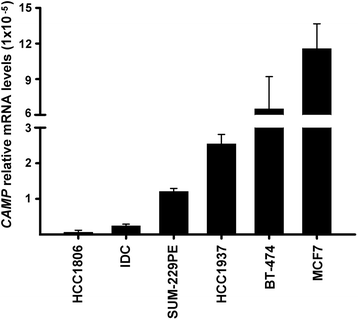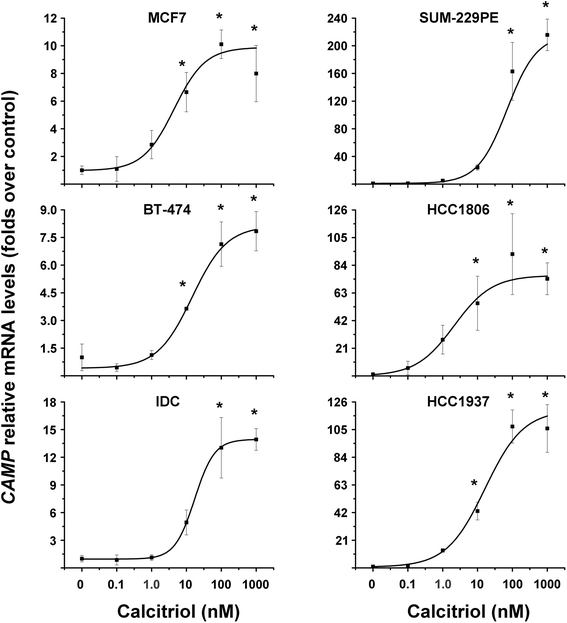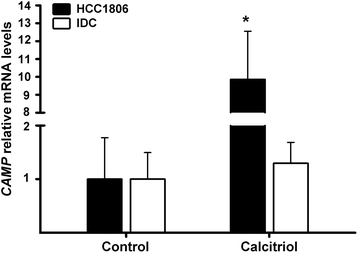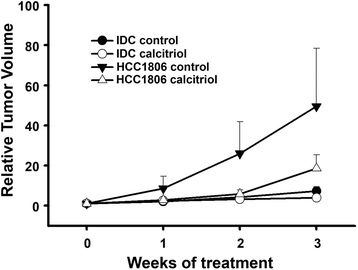Calcitriol stimulates gene expression of cathelicidin antimicrobial peptide in breast cancer cells with different phenotype
- PMID: 27832772
- PMCID: PMC5103596
- DOI: 10.1186/s12929-016-0298-4
Calcitriol stimulates gene expression of cathelicidin antimicrobial peptide in breast cancer cells with different phenotype
Abstract
Background: In normal and neoplastic cells, growth-promoting, proangiogenic, cytotoxic and pro-apoptotic effects have all been attributed to cathelicidin antimicrobial peptide (CAMP). Nevertheless, little is known about the factors regulating this peptide expression in breast cancer. Herein we asked if the well-known antineoplastic hormone calcitriol could differentially modulate CAMP gene expression in human breast cancer cells depending on the cell phenotype in terms of efficacy and potency.
Methods: The established breast cancer cell lines MCF7, BT-474, HCC1806, HCC1937, SUM-229PE and a primary cell culture generated from invasive ductal breast carcinoma were used in this study. Calcitriol regulation of cathelicidin gene expression in vitro and in human breast cancer xenografts was studied by real time PCR. Tumorigenicity was evaluated for each cell line in athymic mice.
Results: Estrogen receptor (ER)α + breast cancer cells showed the highest basal CAMP gene expression. When incubated with calcitriol, CAMP gene expression was stimulated in a dose-dependent and cell phenotype-independent manner. Efficacy of calcitriol was lower in ERα + cells when compared to ERα- cells (<10 vs. >70 folds over control, respectively). Conversely, calcitriol lowest potency upon CAMP gene expression was observed in the ERα-/EGFR+ SUM-229PE cell line (EC50 = 70.8 nM), while the highest was in the basal-type/triple-negative cells HCC1806 (EC50 = 2.13 nM) followed by ERα + cells MCF7 and BT-474 (EC50 = 4.42 nM and 14.6 nM, respectively). In vivo, lower basal CAMP gene expression was related to increased tumorigenicity and lack of ERα expression. Xenografted triple-negative breast tumors of calcitriol-treated mice showed increased CAMP gene expression compared to vehicle-treated animals.
Conclusions: Independently of the cell phenotype, calcitriol provoked a concentration-dependent stimulation on CAMP gene expression, showing greater potency in the triple negative HCC1806 cell line. Efficacy of calcitriol was lower in ERα + cells when compared to ERα- cells in terms of stimulating CAMP gene expression. Lower basal CAMP and lack of ERα gene expression was related to increased tumorigenicity. Our results suggest that calcitriol anti-cancer therapy is more likely to induce higher levels of CAMP in ERα- breast cancer cells, when compared to ERα + breast cancer cells.
Keywords: Breast cancer; Calcitriol; Cathelicidin; LL-37; Vitamin D.
Figures




References
-
- Bruns H, Buttner M, Fabri M, Mougiakakos D, Bittenbring JT, Hoffmann MH, Beier F, Pasemann S, Jitschin R, Hofmann AD, et al. Vitamin D-dependent induction of cathelicidin in human macrophages results in cytotoxicity against high-grade B cell lymphoma. Sci Transl Med. 2015;7:282ra247. doi: 10.1126/scitranslmed.aaa3230. - DOI - PubMed
-
- Heilborn JD, Nilsson MF, Jimenez CI, Sandstedt B, Borregaard N, Tham E, Sorensen OE, Weber G, Stahle M. Antimicrobial protein hCAP18/LL-37 is highly expressed in breast cancer and is a putative growth factor for epithelial cells. Int J Cancer. 2005;114:713–719. doi: 10.1002/ijc.20795. - DOI - PubMed
MeSH terms
Substances
LinkOut - more resources
Full Text Sources
Other Literature Sources
Medical
Research Materials
Miscellaneous

